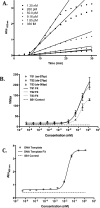Cyclopentane-peptide nucleic acids for qualitative, quantitative, and repetitive detection of nucleic acids
- PMID: 23214925
- PMCID: PMC3535555
- DOI: 10.1021/ac3026459
Cyclopentane-peptide nucleic acids for qualitative, quantitative, and repetitive detection of nucleic acids
Abstract
We report the development of chemically modified peptide nucleic acids (PNAs) as probes for qualitative and quantitative detection of DNA. The remarkable stability of PNAs toward enzymatic degradation makes this class of molecules ideal to develop as part of a diagnostic device that can be used outside of a laboratory setting. Using an enzyme-linked reporter assay, we demonstrate that excellent levels of detection and accuracy for anthrax DNA can be achieved using PNA probes with suitable chemical components designed into the probe. In addition, we report on DNA-templated cross-linking of PNA probes as a way to preserve genetic information for repetitive and subsequent analysis. This report is the first detailed examination of the qualitative and quantitative properties of chemically modified PNA for nucleic acid detection and provides a platform for studying and optimizing PNA probes prior to incorporation into new technological platforms.
Figures




Similar articles
-
Quantification of plasma HIV RNA using chemically engineered peptide nucleic acids.Nat Commun. 2014 Oct 6;5:5079. doi: 10.1038/ncomms6079. Nat Commun. 2014. PMID: 25283173 Free PMC article.
-
PNA-DNA duplexes, triplexes, and quadruplexes are stabilized with trans-cyclopentane units.J Am Chem Soc. 2006 Dec 27;128(51):16456-7. doi: 10.1021/ja064317w. J Am Chem Soc. 2006. PMID: 17177367
-
Cyclopentane FIT-PNAs: bright RNA sensors.Chem Commun (Camb). 2021 Jan 14;57(4):540-543. doi: 10.1039/d0cc07400d. Epub 2020 Dec 18. Chem Commun (Camb). 2021. PMID: 33336664
-
The peptide nucleic acids (PNAs): introduction to a new class of probes for chromosomal investigation.Chromosoma. 2004 Jun;112(8):375-80. doi: 10.1007/s00412-004-0282-8. Epub 2004 May 19. Chromosoma. 2004. PMID: 15156326 Review.
-
A review: fabrications, detections and applications of peptide nucleic acids (PNAs) microarray.Biosens Bioelectron. 2015 Apr 15;66:481-9. doi: 10.1016/j.bios.2014.12.010. Epub 2014 Dec 11. Biosens Bioelectron. 2015. PMID: 25499661 Review.
Cited by
-
Nanopore biosensor for label-free and real-time detection of anthrax lethal factor.ACS Appl Mater Interfaces. 2014 May 28;6(10):7334-9. doi: 10.1021/am500749p. Epub 2014 May 14. ACS Appl Mater Interfaces. 2014. PMID: 24806593 Free PMC article.
-
Peptide Nucleic Acids: Applications in Biomedical Sciences.Molecules. 2020 Jul 22;25(15):3317. doi: 10.3390/molecules25153317. Molecules. 2020. PMID: 32707859 Free PMC article.
-
Perspectives on conformationally constrained peptide nucleic acid (PNA): insights into the structural design, properties and applications.RSC Chem Biol. 2022 Mar 18;3(6):648-697. doi: 10.1039/d2cb00017b. eCollection 2022 Jun 8. RSC Chem Biol. 2022. PMID: 35755191 Free PMC article. Review.
-
A Biotinylated cpFIT-PNA Platform for the Facile Detection of Drug Resistance to Artemisinin in Plasmodium falciparum.ACS Sens. 2024 Mar 22;9(3):1458-1464. doi: 10.1021/acssensors.3c02553. Epub 2024 Mar 6. ACS Sens. 2024. PMID: 38446423 Free PMC article.
-
Quantification of plasma HIV RNA using chemically engineered peptide nucleic acids.Nat Commun. 2014 Oct 6;5:5079. doi: 10.1038/ncomms6079. Nat Commun. 2014. PMID: 25283173 Free PMC article.
References
-
- Ahmad F, Hashsham SA. Anal. Chim. Acta. 2012;733:1–15. - PubMed
-
- Bessetti J. Profiles in DNA. 2007:9–10.
-
- Radstrom P, Knutsson R, Wolffs P, Lovenklev M, Lofstrom C. Mol. Biotechnol. 2004;26:133–146. - PubMed
-
- Inami H, Tsuge K, Matsuzawa M, Sasaki Y, Togashi S, Komano A, Seto Y. Biosensors & Bioelectronics. 2009;24:3299–3305. - PubMed
-
- Ivnitski D, O'Neil DJ, Gattuso A, Schlicht R, Calidonna M, Fisher R. BioTechniques. 2003;35:862–869. - PubMed
Publication types
MeSH terms
Substances
Grants and funding
LinkOut - more resources
Full Text Sources
Other Literature Sources
Molecular Biology Databases

